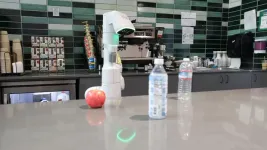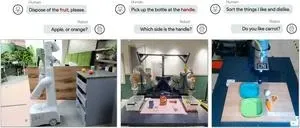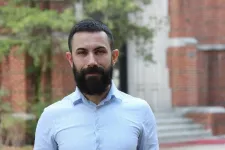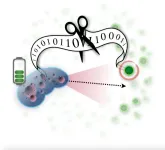(Press-News.org) Modern robots know how to sense their environment and respond to language, but what they don’t know is often more important than what they do know. Teaching robots to ask for help is key to making them safer and more efficient.
Engineers at Princeton University and Google have come up with a new way to teach robots to know when they don’t know. The technique involves quantifying the fuzziness of human language and using that measurement to tell robots when to ask for further directions. Telling a robot to pick up a bowl from a table with only one bowl is fairly clear. But telling a robot to pick up a bowl when there are five bowls on the table generates a much higher degree of uncertainty — and triggers the robot to ask for clarification.
Because tasks are typically more complex than a simple “pick up a bowl” command, the engineers use large language models (LLMs) — the technology behind tools such as ChatGPT — to gauge uncertainty in complex environments. LLMs are bringing robots powerful capabilities to follow human language, but LLM outputs are still frequently unreliable, said Anirudha Majumdar, an assistant professor of mechanical and aerospace engineering at Princeton and the senior author of a study outlining the new method.
“Blindly following plans generated by an LLM could cause robots to act in an unsafe or untrustworthy manner, and so we need our LLM-based robots to know when they don’t know,” said Majumdar.
The system also allows a robot’s user to set a target degree of success, which is tied to a particular uncertainty threshold that will lead a robot to ask for help. For example, a user would set a surgical robot to have a much lower error tolerance than a robot that’s cleaning up a living room.
“We want the robot to ask for enough help such that we reach the level of success that the user wants. But meanwhile, we want to minimize the overall amount of help that the robot needs,” said Allen Ren, a graduate student in mechanical and aerospace engineering at Princeton and the study’s lead author. Ren received a best student paper award for his Nov. 8 presentation at the Conference on Robot Learning in Atlanta. The new method produces high accuracy while reducing the amount of help required by a robot compared to other methods of tackling this issue.
The researchers tested their method on a simulated robotic arm and on two types of robots at Google facilities in New York City and Mountain View, California, where Ren was working as a student research intern. One set of hardware experiments used a tabletop robotic arm tasked with sorting a set of toy food items into two different categories; a setup with a left and right arm added an additional layer of ambiguity.
The most complex experiments involved a robotic arm mounted on a wheeled platform and placed in an office kitchen with a microwave and a set of recycling, compost and trash bins. In one example, a human asks the robot to “place the bowl in the microwave,” but there are two bowls on the counter — a metal one and a plastic one.
The robot’s LLM-based planner generates four possible actions to carry out based on this instruction, like multiple-choice answers, and each option is assigned a probability. Using a statistical approach called conformal prediction and a user-specified guaranteed success rate, the researchers designed their algorithm to trigger a request for human help when the options meet a certain probability threshold. In this case, the top two options — place the plastic bowl in the microwave or place the metal bowl in the microwave — meet this threshold, and the robot asks the human which bowl to place in the microwave.
In another example, a person tells the robot, “There is an apple and a dirty sponge … It is rotten. Can you dispose of it?” This does not trigger a question from the robot, since the action “put the apple in the compost” has a sufficiently higher probability of being correct than any other option.
“Using the technique of conformal prediction, which quantifies the language model’s uncertainty in a more rigorous way than prior methods, allows us to get to a higher level of success” while minimizing the frequency of triggering help, said the study’s senior author Anirudha Majumdar, an assistant professor of mechanical and aerospace engineering at Princeton.
Robots’ physical limitations often give designers insights not readily available from abstract systems. Large language models “might talk their way out of a conversation, but they can’t skip gravity,” said coauthor Andy Zeng, a research scientist at Google DeepMind. “I’m always keen on seeing what we can do on robots first, because it often sheds light on the core challenges behind building generally intelligent machines.”
Ren and Majumdar began collaborating with Zeng after he gave a talk as part of the Princeton Robotics Seminar series, said Majumdar. Zeng, who earned a computer science Ph.D. from Princeton in 2019, outlined Google’s efforts in using LLMs for robotics, and brought up some open challenges. Ren’s enthusiasm for the problem of calibrating the level of help a robot should ask for led to his internship and the creation of the new method.
“We enjoyed being able to leverage the scale that Google has” in terms of access to large language models and different hardware platforms, said Majumdar.
Ren is now extending this work to problems of active perception for robots: For instance, a robot may need to use predictions to determine the location of a television, table or chair within a house, when the robot itself is in a different part of the house. This requires a planner based on a model that combines vision and language information, bringing up a new set of challenges in estimating uncertainty and determining when to trigger help, said Ren.
The paper, “Robots That Ask for Help: Uncertainty Alignment for Large Language Model Planners,” was presented Nov. 8 at the Conference on Robot Learning. In addition to Ren, Zeng and Majumdar, coauthors include Anushri Dixit and Alexandra Bodrova of Princeton; and Sumeet Singh, Stephen Tu, Noah Brown, Peng Xu, Leila Takayama, Fei Xia, Jake Varley, Zhenjia Xu and Dorsa Sadigh of Google DeepMind. The research was supported in part by the U.S. National Science Foundation and the Office of Naval Research.
END
How do you make a robot smarter? Program it to know what it doesn’t know
2023-11-29
ELSE PRESS RELEASES FROM THIS DATE:
Researchers working to develop next-generation polymer membranes for sustainable materials science
2023-11-28
Michele Galizia, a President’s Associates Presidential Professor in the School of Sustainable Chemical, Biological and Materials Engineering at the University of Oklahoma, is leading a research team that recently received a grant from the U.S. Department of Energy that will develop improved polymer membranes to advance molecular separation and related materials science.
“We currently separate chemicals, gases and liquids using a thermal-based distillation technology that is very expensive to operate and consumes the equivalent of eight GJ of electricity per person on the planet per year,” ...
Researchers have applied the theory of semantic information to a realistic model capturing attributes of living systems—and found the critical point where information matters for survival
2023-11-28
Living systems—unlike non-living or inanimate objects—use information about their surrounding environment to survive. But not all information from the environment is meaningful or relevant for survival. The subset of information that is meaningful, and perhaps necessary for being alive, is called semantic information.
In a new paper published in PRX Life, University of Rochester physicists and their coauthors have, for the first time, applied this theory of semantic information to a well-known ...
Growing microtumors in a dish helps rapidly identify genes that drive tumor growth
2023-11-28
Researchers have identified a new way to screen genes that cause several different types of cancers to grow, identifying particularly promising targets for precision oncology in oral and esophageal squamous cancers.
The study, published in this month’s issue of Cell Reports, used 3-dimensional models of organ tissues called organoids to identify and test potential gene targets from The Cancer Genome Atlas.
“There’s a tremendous amount of data in The Cancer Genome Atlas, ...
New research compares five retinoids for anti-photoaging therapy
2023-11-28
Over the past decades, increasing evidences have demonstrated that five retinoids, including retinol (ROL), retinol acetate (RAc), retinol propionate (RP), retinol palmitate (RPalm), and hydroxypinacolone retinoate (HPR), can be potential therapeutic agents for skin photoaging. However, therapeutic efficacies and biosafety have never been compared to these compounds. This study aimed to determine the optimal retinoid type(s) for anti-photoaging therapy both in vitro and in vivo.
The data demonstrated that four retinoids (RPalm, RP, HPR and ROL) but not RAc were effective for anti-photoaging treatment at 5 μg/mL in vitro, with action mechanisms associated with antioxidative, ...
Can health, lifestyle changes protect elders from Alzheimer's?
2023-11-28
As more medications move toward federal approval for Alzheimer’s disease, a new study led by researchers at UC San Francisco and Kaiser Permanente Washington has found that personalized health and lifestyle changes can delay or even prevent memory loss for higher-risk older adults.
The two-year study compared cognitive scores, risk factors and quality of life among 172 participants, of whom half had received personalized coaching to improve their health and lifestyle in areas believed to raise the risk of Alzheimer’s, such as uncontrolled diabetes and physical inactivity. These participants were ...
Millions of kids in U.S. have inadequate health care coverage
2023-11-28
November 28, 2023-- Inadequate health coverage is a particular problem for commercially insured children, according to a new study released by Columbia University Mailman School of Public Health. The research shows that coverage gaps are affecting publicly insured children as well. Until now, prior research had focused on documenting rates and trends in insurance consistency for children covered by all insurance types. The findings are published in JAMA Health Forum.
“While uninsurance among children has generally been declining in the U.S., our results highlight the need for a renewed focus on making sure that children’s ...
NIH awards $2.6 million to Wayne State to develop new filtration platform for insulin administration
2023-11-28
DETROIT – A Wayne State University College of Engineering professor has received a $2.65 million award from the National Institute of Diabetes and Digestive and Kidney Diseases of the National Institutes of Health to develop a novel filtration platform to improve an advanced drug delivery device to optimize diabetes insulin treatments.
Subcutaneous insulin administration (SIA) technology has improved significantly over the past two decades, but SIA technology failure and underlying tissue damage caused by insulin phenolic preservatives ...
Mayo Clinic Board of Trustees approves plans to transform healthcare, improve experience for staff and patients, redesign Rochester campus
2023-11-28
ROCHESTER, Minn. — Mayo Clinic’s Board of Trustees has approved Bold. Forward. Unbound. in Rochester, a multiyear strategic initiative that advances Mayo Clinic’s Bold. Forward. strategy to Cure, Connect and Transform healthcare for the benefit of patients everywhere. It reimagines Mayo Clinic’s downtown Rochester campus and introduces new facilities with a combination of innovative care concepts and digital technologies that will give Mayo Clinic the ability to scale transformation ...
Threats against public health workers doubled during the COVID-19 pandemic
2023-11-28
While doctors and nurses were hailed as the frontline heroes of the COVID-19 pandemic, their counterparts in public health were experiencing threats. During the pandemic, threats against public health workers reached an all-time high. After the vaccine was released, those threats increased and changed in nature, according to a longitudinal study conducted during the first year of the pandemic by Jennifer Horney, founder of the University of Delaware Epidemiology Program in the College of Health Sciences.
The results, recently published in an open-access commentary in Public Health in Practice, show a strong need for expanded legal protections ...
Reducing inequitable health outcomes requires reducing residential segregation
2023-11-28
The U.S. must reduce racial residential segregation if it is to reduce racial disparities in health outcomes, according to a recently published study by researchers at Tufts University School of Medicine. The research on 220 metropolitan areas nationwide between 1980 and 2020 found strong links between trends in racial residential segregation and racial disparities in early death rates from a variety of causes.
The study is the first known to examine the association between changes in racial segregation over time ...





